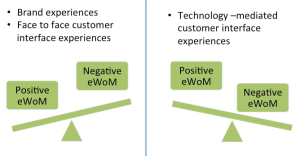Jan Kietzmann and I have been investigating how social media users talk about their consumption experiences online, a phenomenon called “electronic Word of Mouth”, or eWoM. While there is considerable research regarding why and, to an extent, how consumers engage in eWoM, our research is novel in that it:
- Investigates how different aspects of the consumption experience influence eWoM, and
- Considers not the experience in itself, but the consumers’ assessment of the experience
- Is not specific to one single social media platform
This post give a very brief overview of our findings, and the full paper can be accessed here (paywall) or here. We have both good news and bad news for marketing managers.
But, first, let me tell you a little bit about the framing of our study.
What we looked at
 Think about the last time you bought a coffee. Was your satisfaction with the experience just determined by the coffee in itself? Most probably not. It was the result of a number of factors about the product, the cup in which it was delivered to you, the presence (or absence) of logos and brand signage, and so on. It was also influenced by your interaction with the staff or, in the case of self-service, the machine delivering your product. Schmitt calls the former ‘brand experiences’ and the latter ‘customer interface experiences’. So, rather than simply talking about consumption experiences, Jan and I broke these down into its various elements, using Schmitt’s classification.
Think about the last time you bought a coffee. Was your satisfaction with the experience just determined by the coffee in itself? Most probably not. It was the result of a number of factors about the product, the cup in which it was delivered to you, the presence (or absence) of logos and brand signage, and so on. It was also influenced by your interaction with the staff or, in the case of self-service, the machine delivering your product. Schmitt calls the former ‘brand experiences’ and the latter ‘customer interface experiences’. So, rather than simply talking about consumption experiences, Jan and I broke these down into its various elements, using Schmitt’s classification.
Further, we adopted a subjective view of satisfaction. Ultimately, it does not matter how good or bad the coffee is, what matters is the consumers’ appraisal of that coffee. In turn, my appraisal depends on my goals (e.g., whether I want sugar with that coffee), what I came to expect as a result of previous experience or of what others told me (e.g., a product review), and the general standards for similar products (e.g., sugar is usually provided free of charge with your coffee). As such, rather than looking simply at customers’ assessment of the experience, Jan and I broke it down in terms of its drivers – i.e., goals, previous experiences, etc.
Finally, we also looked at different types of social media platforms. Existing studies tend to look at only one platform – for instance, Twitter or Trip Advisor, only. However, social media users have access to – and may use – more than one platform. Moreover, they may use each platform differently. So, we wanted to understand how use of the various social platforms varied due to satisfaction or dissatisfaction with different elements of the consumption experience, and the source of the disconfirmation.
What we found
Channels used
 Even though well known social media crisis like Domino’s “Pizzas Special Ingredients” or United Airline’s “United Breaks Guitars” revolved around videos posted on YouTube, according to our sample, consumers mostly use Facebook and Twitter to comment on their consumption experiences. We think that these 2 specific platforms represent the easiest option for customers, from a technical perspective. After all, it does take some effort to produce a video for YouTube or to set up a blog or website. Moreover, Twitter and Facebook are, also, very popular social media platforms in large parts of the world, which many consumers use routinely, already, and so they become the natural vehicle for customers to comment on their experiences.
Even though well known social media crisis like Domino’s “Pizzas Special Ingredients” or United Airline’s “United Breaks Guitars” revolved around videos posted on YouTube, according to our sample, consumers mostly use Facebook and Twitter to comment on their consumption experiences. We think that these 2 specific platforms represent the easiest option for customers, from a technical perspective. After all, it does take some effort to produce a video for YouTube or to set up a blog or website. Moreover, Twitter and Facebook are, also, very popular social media platforms in large parts of the world, which many consumers use routinely, already, and so they become the natural vehicle for customers to comment on their experiences.
Positive vs. negative experiences
 Managers could be excused from thinking that their customers mostly complain about their brands / products. But they need not despair. Actually, social media users are more likely to talk about positive aspects than negative ones – this applies to the brand experience elements and to face-to-face interactions. What happens is that customers tend to talk about their positive experiences on Facebook, which may not be accessible to firms, depending on the users’ privacy settings. However, when social media users choose to voice their disappointment, then they use Twitter and anyone can see that negative comment. So, while consumers are more likely to talk positively than negatively online, they will praise in private and criticise in public.
Managers could be excused from thinking that their customers mostly complain about their brands / products. But they need not despair. Actually, social media users are more likely to talk about positive aspects than negative ones – this applies to the brand experience elements and to face-to-face interactions. What happens is that customers tend to talk about their positive experiences on Facebook, which may not be accessible to firms, depending on the users’ privacy settings. However, when social media users choose to voice their disappointment, then they use Twitter and anyone can see that negative comment. So, while consumers are more likely to talk positively than negatively online, they will praise in private and criticise in public.
The exception to this behaviour is when the interaction with the firm is not face-to-face. Specifically, if the interaction takes place through a technological interface (e.g., by e-mail or a website), customers are more likely to engage in negative eWoM than positive one.
Norms as hygiene factor
In terms of drivers of negative eWoM – i.e., criticism – it seems that the key factor is the general standard. For instance, if the standard for the industry is free sugar, or 2 hours reply to an e-mail, and service falls below that standard, customers will be unhappy. The standard becomes the hygiene factor in customer satisfaction.
 Expectations as motivating factor
Expectations as motivating factor
The tricky bit is that positive disconfirmation and, hence, satisfaction and positive eWoM are largely influenced by individual expectations. That is, it’s not enough to be better than the competition (i.e., the industry norm) – for instance, handing out biscuits and sugar free of charge, whereas your competitors only provide the latter. What really matters for positive eWoM is what the customer came to expect of you following precious experiences and reviews.
So, the first time you give the free biscuits, the customer is delighted and will post it on Facebook, but expectations will quickly adjust and, soon, the biscuit will become the ‘normal’ for this customer, not the extraordinary that gets them talking. So delight your customers, yes, but try to think of non-costly ways of doing that, because your investment will quickly go unnoticed.
Do our findings reflect your own experience?


Interesting! Thank you for a fine Study!
LikeLike
Reblogged this on Social Media Marketing 4 Business and commented:
With Ana Canhoto’s permission her post about how customer’s complain and compliment brands and products in social media is posted here.
Her post illuminates an issue raised in an earlier post in this blog on social media complaints. http://smm4biz.com/2013/09/24/social-media-complaints-put-it-to-them/
I recommend readers interested in marketing research follow her blog!
LikeLike
This is interesting for me – I deal with brands and their perceptions of their customers perceptions – on a daily basis – only Im looking at it on-domain for the brand, ie on their Forums, Blogs and Ideation platforms.
Brands need a thick skin and those that are hyper sensitive to ‘bitching and moaning’ loose their flow in being social and – coming at this with a US mindset – you do need to experiment with these innovative practices and be prepared to learn and fail and learn some more. (We are not good at that thinking in the UK – we expect perfection, Best Practice and to be smart informed executioners – even in a nascent context like social.)
The twist in the tale that I like so much is that the firm that is number one on the global NPS rankings has an on-domain forum for its customers (a community) that has some of the whiniest comments – to the point that many of my sales colleagues cringe away from showing it to other clients. The language used by brand advocates/terrorists embarrasses us.
When the brand is rosy (NPS is probably the most credible brand sentiment measure right now – non of the social sentiment data has any credence in the boardroom) – the language used in open, free, psychologically safe fora doesn’t correlate.
From my personal experience, I try not to whinge on twitter (but I know a 5% whinge factor would make my digital voice more authentic) and I proactively unfollow people who complain about FGW and Chiltern trains experience – because I just don’t need negativity in my day – and lets face it, if trains in UK were easy to fix we would have done it by now….
A wonderful example I found last week was with BA (I was researching why BA are perceived as so awesome by UK’s Gen Y)… Check out this http://youtu.be/1n-9-6ULjHY and look at the comments and the Likes against BA’s response to “74jac06”.
Seeing BA being accountable and owning the “difficult conversation” gives them Kudos. Well done BA.
My LA-bred counterpart at Lithium would say “BA are sick!” – Now lets scratch our heads and try and classify his sentiment… Im sure he is being positive
😉
LikeLike
Ooh – good example for my class. Thank you 🙂
But you are right that these very public conversations are quite a challenge for companies – and not just the negative comments. @toddbacile is looking into this issue of conversations between customers, brands and other customers. A space to watch, for sure.
PS – Everything ready for Friday?
LikeLike
Reblogged this on Social Media Syllabus and commented:
This is my first “reblog!” I want to share a great blog post by Ana Canhoto that I came across. This article describes the results of her research into social media and electronic word of mouth about brands. Specifically, the study looks at positive and negative online expression of consumer experiences with a brand. Enjoy!
Very interesting. I will be following her work! Check it out at http://anacanhoto.com.
LikeLike